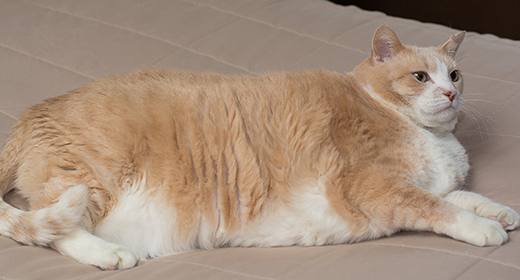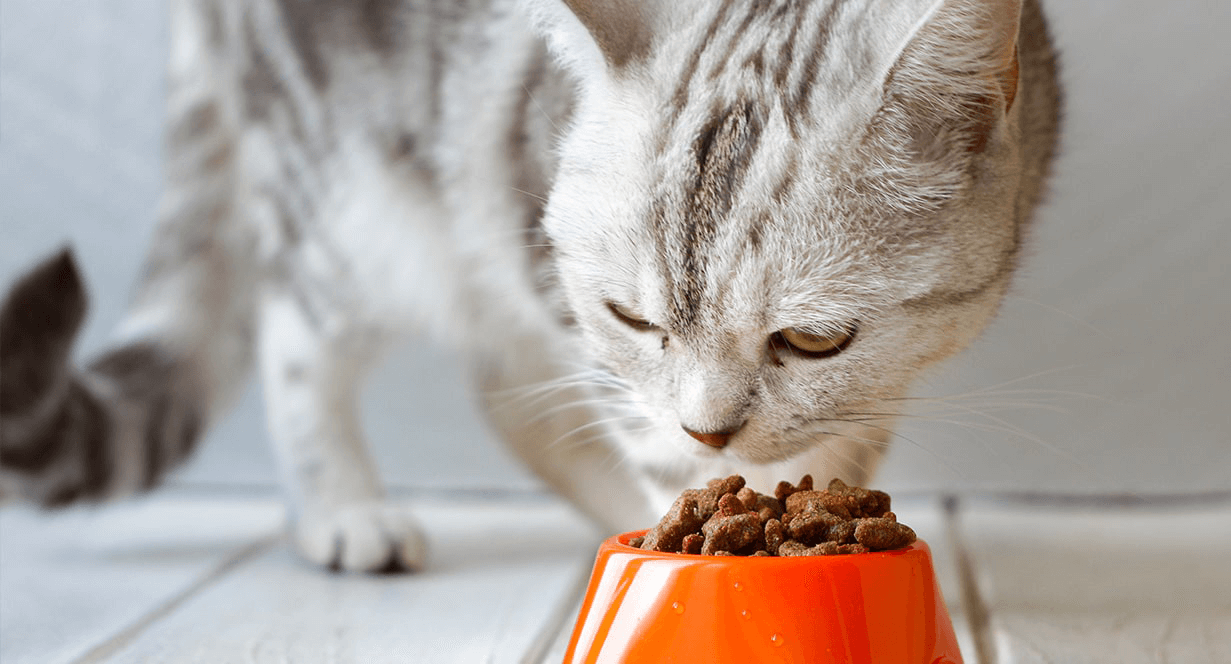

An obese cat is not a pretty sight. Cumbersome and clumsy, they suffer a marked loss in athletic ability and appearance. Decreased flexibility prevents them from thoroughly grooming, which can cause skin problems. Obese cats also have an increased risk for diabetes and are poor candidates for surgery and anesthesia.
Obesity results when an animal consistently eats more calories than they need. This can be caused by overfeeding, inactivity, reproductive status, environment, body type, age or genetics.
Assessing body condition is important in the overall evaluation of your cat’s nutritional well-being and can help in determining feline obesity. Take a few moments to follow the easy directions in the Cat Body Condition Chart for assessing your cat’s body condition.
If you suspect your cat is obese, the first step is to consult your veterinarian.
Your veterinarian will probably ask you some questions about your cat, such as how much they eat and how much physical activity they get. Answering these questions honestly will help your veterinarian recommend some simple changes to help improve your cat’s weight. Your veterinarian may also perform tests to detect medical conditions that may contribute to obesity — you want to rule these out before starting your cat on any weight-management program.
Your veterinarian may first suggest reducing the amount you feed your cat. If so, begin by reducing the daily portion by 25%. Continue decreasing intake by 10% increments every two to three weeks until your cat loses 1% of their starting weight. For example, if your cat weighs 15 pounds, a 1% loss would be 2½ ounces.
If you feed one large meal a day, or keep food available at all times, try dividing the daily ration into several small meals (at least two meals a day) and pick up what your cat doesn’t eat 30 minutes after each meal.
A diet that contains slowly digested carbohydrates, such as corn and sorghum, can result in lower blood sugar and insulin levels than a diet that contains rice as the primary carbohydrate source. Lower blood sugar and insulin levels can also help with maintaining a proper weight.
Changing diets can be stressful for pets, so if your veterinarian recommends changing diets, proceed slowly.
Begin with a daily portion that mixes 25% of the new food with 75% of the old food. The next day, increase the amount of new food to 50% and decrease the amount of the old food to 50%. During the next few days, continue increasing the proportions of the new food and decreasing the amount of old food until the food consists entirely of the new diet. This method increases the likelihood that your cat will accept the new diet and decreases the occurrence of stomach upsets.
Another way to help your cat lose weight is to increase their activity. Provide cat trees for climbing, or teach your cat to play fetch or walk on a leash. Buy or create your own toys that encourage exercise. One ingenious owner tosses her cat’s dry food ration across the room a piece at a time!
You also can use your cat’s natural hunting instinct to help them lose weight. Hide several small portions of their daily food ration around the house. If you have a multilevel home, make your cat use the stairs.
Use your imagination, but be cautious. Don’t let a fat cat get exhausted, overheated or out of breath. Also, keep in mind that a senior cat may not be able to exercise vigorously.
Replace food treats with rewards like playtime, grooming, stroking or conversation. If you cannot resist the fat cat who begs for food at the dinner table, keep them in another room during dinnertime. If you have a multi-cat household, the consistent winner of the food competition sweepstakes is often obese. If this is the case, separate the cats at mealtimes if possible.
Obesity is easier to prevent than to cure, but it is never too late to reverse it — though it requires long-term patience and commitment. Helping cats lose weight is a slow process. If the amount they eat is severely restricted, the cat risks other health problems.
Increased activity, behavior modification (for both you and your cat) and calorie restriction are your best tools for helping an obese cat lose weight. However, it is important to expect a few setbacks and plateaus. It will take at least four months for an obese cat to lose 15% of their starting weight. At that point, have another look at your cat’s body condition and go from there.
Tips for Starting a Weight-management Program for Your Cat


Your cat is one of a kind, so it stands to reason that you want to choose a cat food that accounts for their unique tastes, age, breed and health concerns. But with thousands of pet foods available, how do you pick the one that’s right for your cat?
First, it’s important to understand your cat’s nutritional needs. Then, you’ll need to think about your cat’s life stage, lifestyle and any health issues, and do a bit of research on cat food types, ingredients and cost. That may sound complicated, but we’ll make it easy for you — just keep reading.
Good nutrition is as important to your cat as it is to you — but their nutritional needs are quite different! Unlike humans, a cat needs a high-fat diet with less fiber. And even if you prefer a vegetarian diet, keep in mind that cats are carnivores. They need nutrients from animal protein and fat for optimal health, and they benefit from fiber for a healthy digestive tract and carbohydrates for energy.
Kittens, adult cats, nursing mothers and mature or senior cats are all examples of life stages, and each has different nutritional requirements. All cat foods should state which life stage they are recommended for — as an example, IAMS™ Proactive Health™ Mother and Kitten as well as IAMS™ Proactive Health™ Healthy Adult include the intended life stage right on the package.
Nutritional needs also vary depending on your cat’s lifestyle. A cat whose primary activity is guarding the couch doesn’t need as much energy as one who enjoys roaming outside.
.
Because cats need the nutrients found in animal sources, it’s best to pick a food in which a primary ingredient (one of the first ones listed) is an animal-based protein source such as chicken, lamb, fish, egg or one of their by-products. These ingredients contain all the essential amino acids your cat needs, including taurine, which isn’t found in a plant-based protein source. Foods that include a combination of carbohydrates in your cat’s diet, such as corn meal or barley and grain sorghum, ensure efficient absorption of nutrients and help maintain energy levels. And beet pulp is an excellent fiber source that promotes a healthy digestive tract.
For a soft, thick coat and healthy skin, your pet needs fatty acids like those found in vitamin-rich fish oils and quality fat sources such as chicken.
Cat food labels provide limited information on the nutritional value of your pet’s food because labeling regulations do not allow manufacturers to describe the quality of ingredients on the package. A reputable pet food manufacturer can explain how they evaluate and ensure the quality of their products.
When choosing cat food, the saying “You get what you pay for” definitely applies. A low price may indicate cheap ingredients or ingredients that change as manufacturer costs fluctuate. So while price is an important factor, it shouldn’t be the only one you consider.
Plus, many lower-priced products recommend higher daily portions to provide the same amount of nutrition found in a high-quality diet. To get a better idea of cost, it is the cost per feeding, not the total cost, that counts.
To figure out the cost per feeding for a cat food, divide the total cost by the number of days the product lasts. When compared closely, high-quality pet foods tend to come out on top, from both a nutritional and a cost standpoint.